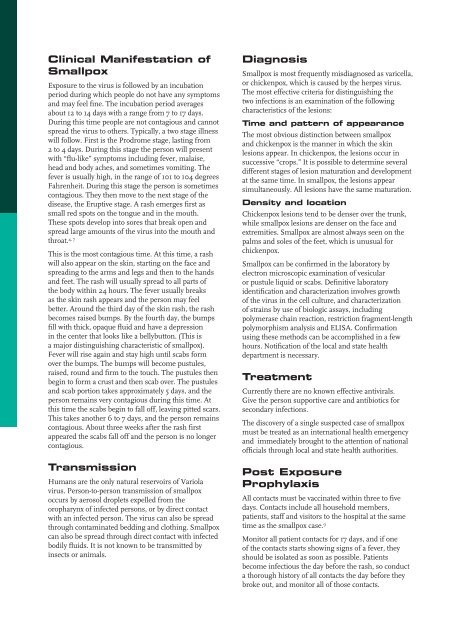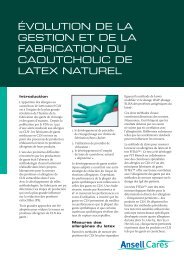Download full document (pdf) - Ansell Healthcare Europe
Download full document (pdf) - Ansell Healthcare Europe
Download full document (pdf) - Ansell Healthcare Europe
You also want an ePaper? Increase the reach of your titles
YUMPU automatically turns print PDFs into web optimized ePapers that Google loves.
Clinical Manifestation of<br />
Smallpox<br />
Exposure to the virus is followed by an incubation<br />
period during which people do not have any symptoms<br />
and may feel fine. The incubation period averages<br />
about 12 to 14 days with a range from 7 to 17 days.<br />
During this time people are not contagious and cannot<br />
spread the virus to others. Typically, a two stage illness<br />
will follow. First is the Prodrome stage, lasting from<br />
2 to 4 days. During this stage the person will present<br />
with “flu-like” symptoms including fever, malaise,<br />
head and body aches, and sometimes vomiting. The<br />
fever is usually high, in the range of 101 to 104 degrees<br />
Fahrenheit. During this stage the person is sometimes<br />
contagious. They then move to the next stage of the<br />
disease, the Eruptive stage. A rash emerges first as<br />
small red spots on the tongue and in the mouth.<br />
These spots develop into sores that break open and<br />
spread large amounts of the virus into the mouth and<br />
4, 7 throat.<br />
This is the most contagious time. At this time, a rash<br />
will also appear on the skin, starting on the face and<br />
spreading to the arms and legs and then to the hands<br />
and feet. The rash will usually spread to all parts of<br />
the body within 24 hours. The fever usually breaks<br />
as the skin rash appears and the person may feel<br />
better. Around the third day of the skin rash, the rash<br />
becomes raised bumps. By the fourth day, the bumps<br />
fill with thick, opaque fluid and have a depression<br />
in the center that looks like a bellybutton. (This is<br />
a major distinguishing characteristic of smallpox).<br />
Fever will rise again and stay high until scabs form<br />
over the bumps. The bumps will become pustules,<br />
raised, round and firm to the touch. The pustules then<br />
begin to form a crust and then scab over. The pustules<br />
and scab portion takes approximately 5 days, and the<br />
person remains very contagious during this time. At<br />
this time the scabs begin to fall off, leaving pitted scars.<br />
This takes another 6 to 7 days, and the person remains<br />
contagious. About three weeks after the rash first<br />
appeared the scabs fall off and the person is no longer<br />
contagious.<br />
Transmission<br />
Humans are the only natural reservoirs of Variola<br />
virus. Person-to-person transmission of smallpox<br />
occurs by aerosol droplets expelled from the<br />
oropharynx of infected persons, or by direct contact<br />
with an infected person. The virus can also be spread<br />
through contaminated bedding and clothing. Smallpox<br />
can also be spread through direct contact with infected<br />
bodily fluids. It is not known to be transmitted by<br />
insects or animals.<br />
Diagnosis<br />
Smallpox is most frequently misdiagnosed as varicella,<br />
or chickenpox, which is caused by the herpes virus.<br />
The most effective criteria for distinguishing the<br />
two infections is an examination of the following<br />
characteristics of the lesions:<br />
Time and pattern of appearance<br />
The most obvious distinction between smallpox<br />
and chickenpox is the manner in which the skin<br />
lesions appear. In chickenpox, the lesions occur in<br />
successive “crops.” It is possible to determine several<br />
different stages of lesion maturation and development<br />
at the same time. In smallpox, the lesions appear<br />
simultaneously. All lesions have the same maturation.<br />
Density and location<br />
Chickenpox lesions tend to be denser over the trunk,<br />
while smallpox lesions are denser on the face and<br />
extremities. Smallpox are almost always seen on the<br />
palms and soles of the feet, which is unusual for<br />
chickenpox.<br />
Smallpox can be confirmed in the laboratory by<br />
electron microscopic examination of vesicular<br />
or pustule liquid or scabs. Definitive laboratory<br />
identification and characterization involves growth<br />
of the virus in the cell culture, and characterization<br />
of strains by use of biologic assays, including<br />
polymerase chain reaction, restriction fragment-length<br />
polymorphism analysis and ELISA. Confirmation<br />
using these methods can be accomplished in a few<br />
hours. Notification of the local and state health<br />
department is necessary.<br />
Treatment<br />
Currently there are no known effective antivirals.<br />
Give the person supportive care and antibiotics for<br />
secondary infections.<br />
The discovery of a single suspected case of smallpox<br />
must be treated as an international health emergency<br />
and immediately brought to the attention of national<br />
officials through local and state health authorities.<br />
Post Exposure<br />
Prophylaxis<br />
All contacts must be vaccinated within three to five<br />
days. Contacts include all household members,<br />
patients, staff and visitors to the hospital at the same<br />
time as the smallpox case. 9<br />
Monitor all patient contacts for 17 days, and if one<br />
of the contacts starts showing signs of a fever, they<br />
should be isolated as soon as possible. Patients<br />
become infectious the day before the rash, so conduct<br />
a thorough history of all contacts the day before they<br />
broke out, and monitor all of those contacts.

















